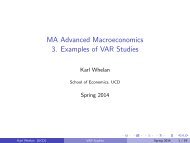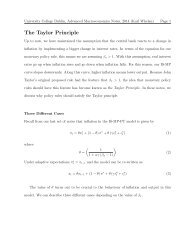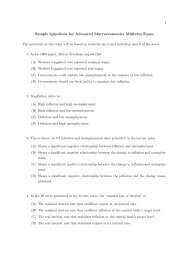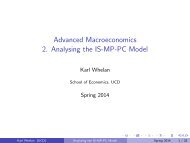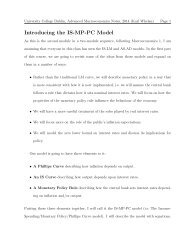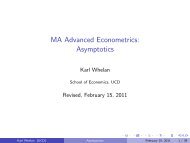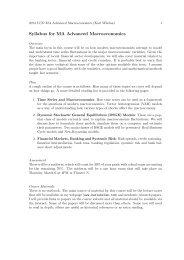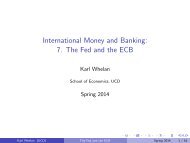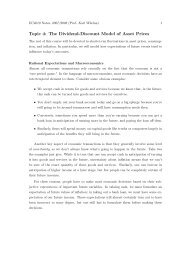Topic 1: The Solow Model of Economic Growth - Karl Whelan
Topic 1: The Solow Model of Economic Growth - Karl Whelan
Topic 1: The Solow Model of Economic Growth - Karl Whelan
You also want an ePaper? Increase the reach of your titles
YUMPU automatically turns print PDFs into web optimized ePapers that Google loves.
EC4010 Notes, 2007/2008 (Pr<strong>of</strong>. <strong>Karl</strong> <strong>Whelan</strong>) 1<strong>Topic</strong> 1: <strong>The</strong> <strong>Solow</strong> <strong>Model</strong> <strong>of</strong> <strong>Economic</strong> <strong>Growth</strong>About This CourseAlthough some <strong>of</strong> the topics we will cover will be familiar to you, the overall approachtaken in this class will perhaps be more formal than you have seen before. We will tend touse a more mathematical approach to derive solutions to models and to characterise theirproperties. In some cases, this will involve introducing methods that you may not haveseen before.While this approach to macroeconomics may seem a little austere to some <strong>of</strong> you,it has some important advantages. For instance, a particular economic policy proposalmight sound appealing, but an analytical examination could reveal drawbacks that are notclear from casual thinking. Writing down a formal economic model also allows one to beprecise about the assumptions that need to be made to justify a particular policy proposal.Beyond the implications for applied policy analysis, the formal approach fits well with themodern econometric approach to testing economic theories. By providing explicit solutionsfor the determinants <strong>of</strong> various macroeconomic variables, this approach leads one moredirectly towards testable econometric equations. For those <strong>of</strong> you who intend to studymore economics after this course, we hope to give you a flavour <strong>of</strong> the modern approach tomacroeconomics, and perhaps teach you a few tools that may prove useful in the future.Questions in <strong>Growth</strong> <strong>The</strong>ory and the <strong>Solow</strong> <strong>Model</strong>We will spend the first part <strong>of</strong> this course on what is known as “growth theory.” Thisbranch <strong>of</strong> macroeconomics concerns itself with big-picture questions: What determines thegrowth rate <strong>of</strong> the economy over the long run and what can policy measures do to affectit? This is, <strong>of</strong> course, related to the even more fundamental question <strong>of</strong> what makes somecountries rich and others poor.A useful starting point for illustrating the questions addressed by growth theory isthe idea that output is produced using an aggregate production function technology. Forillustration, assume that this takes the form <strong>of</strong> a constant returns to scale Cobb-Douglasproduction function:Y t = A t K α t L 1−αt 0 < α < 1 (1)where K t is capital input and L t is labour input. Note that an increase in A t results inhigher output without having to raise inputs. Macroeconomists usually call increases in
EC4010 Notes, 2007/2008 (Pr<strong>of</strong>. <strong>Karl</strong> <strong>Whelan</strong>) 2A t “technological progress” and sometimes I will loosely refer to this as the “technology”term, but ultimately A t is simply a measure <strong>of</strong> productive efficiency. Because an increasein A t increases the productiveness <strong>of</strong> the other factors, it is also sometimes known as TotalFactor Productivity (TFP), and this is the term most commonly used in empirical papersthat attempt to calculate this series.<strong>Growth</strong> theory is primarily interested in the determination <strong>of</strong> output per person in theeconomy, rather than total output. For this reason, we will focus more on the determination<strong>of</strong> output per worker. This is obtained by dividing both sides <strong>of</strong> equation (1) by L t to getY tL t= A t( KtL t) α(2)This equation shows that, with a constant returns production function, there are two waysto increase output per worker:• Capital deepening (i.e. increases in capital per worker)• Technological progress: Improving the efficiency with which an economy uses itsinputs.One <strong>of</strong> the central question addressed by growth theory is the relative importance <strong>of</strong> thesetwo sources <strong>of</strong> growth. This question is important because policies that focus on capitaldeepening (for instance, by tax policies aimed at boosting investment) are <strong>of</strong>ten likely to bequite different from policies that attempt to boost technological efficiency. Exactly whatfactors determine technological efficiency is another important question for growth theoryand for the empirical study <strong>of</strong> economic growth.An Alternative Expression for Output Per WorkerI also want to introduce an alternative characterisation <strong>of</strong> output per worker that turns outto be very useful. First, we’ll define the capital-output ratio asSo, the production function can be expressed asx t = K tY t(3)Y t = A t (x t Y t ) α L β t (4)Here, we are using the fact thatK t = x t Y t (5)
EC4010 Notes, 2007/2008 (Pr<strong>of</strong>. <strong>Karl</strong> <strong>Whelan</strong>) 3Dividing both sides <strong>of</strong> this expression by Y αt , we getTaking both sides <strong>of</strong> the equation to the power <strong>of</strong>11−αSo, output per worker isY tY 1−αt = A t x α t L β t (6)Y t = AL t= A11−αt11−αtxxα1−αtα1−αtβwe arrive at1−αLt (7)β1−α −1Lt (8)If the economy has constant returns to scale, so that β = 1 − α, this simplifies toY tL t= A11−αtα1−αxt (9)This equation states that all fluctuations in output per worker are due to either changes intechnological progress or changes in the capital-output ratio. When considering the relativerole <strong>of</strong> technological progress or policies to encourage accumulation, we will see that thisdecomposition is more useful than equation (2) because the level <strong>of</strong> technology does notaffect x t in the long run while it does affect KtL t. So, this decomposition <strong>of</strong>fers a cleanerpicture <strong>of</strong> the part <strong>of</strong> growth due to technology and the part that is not.Some Mathematical TricksWe are interested in modelling changes over time in outputs and inputs. A useful mathematicalshorthand that saves us from having to write down derivatives with respect to timeeverywhere is to writeẎ t = dY tdtWhat we are really interested in, though, is growth rates <strong>of</strong> series: If I tell you GDP wasup by 5 million euros, that may sound like a lot, but unless we scale it by the overall level<strong>of</strong> GDP, it’s not really very useful information. Thus, what we are interested in calculatingis ẎtY t, and this is our mathematical expression for the growth rate <strong>of</strong> a series.Now, I’m going to introduce one <strong>of</strong> the techniques that we will use to obtain growthrates for variables <strong>of</strong> interest. This involves using logarithims. <strong>The</strong> reason for this is thefollowing property:d (log Y t )dt(10)= d (log Y t) dY tdY t dt = Y ˙ t(11)Y t
EC4010 Notes, 2007/2008 (Pr<strong>of</strong>. <strong>Karl</strong> <strong>Whelan</strong>) 4<strong>The</strong> growth rate <strong>of</strong> a series is the same as the derivative <strong>of</strong> its log with respect to time (notethe use <strong>of</strong> chain-rule <strong>of</strong> differentiation in the above equation.)Two other useful properties <strong>of</strong> logarithms that will also help us characterise the dynamics<strong>of</strong> growth models are the following:log (XY ) = log X + log Y (12)( )log X Y = Y log X (13)To illustrate how to use the properties <strong>of</strong> logarithms to get growth rates, let’s consider againthe constant returns to scale Cobb-Douglas production function from equation (1). Takinglogs <strong>of</strong> both sides <strong>of</strong> this equation, and then using the properties <strong>of</strong> the log function, we getlog(Y t ) = log(A t K α t L 1−αt ) (14)= log(A t ) + log(K α t ) + log(L 1−αt ) (15)= log(A t ) + α log(K t ) + (1 − α)log(L t ) (16)Now taking the derivative with respect to time, we get the required formula:Y˙t A= ˙ t K+ α ˙ t L+ (1 − α) ˙ t(17)Y t A t K t L tThis takes us from the Cobb-Douglas formula involving levels to a simple formula involvinggrowth rates. <strong>The</strong> growth rate <strong>of</strong> output per worker is simplyY˙t L− ˙ t= ˙ (A t K ˙ t+ α − ˙ )L tY t L t A t K t L tThis is a re-statement in growth rate terms <strong>of</strong> our earlier decomposition <strong>of</strong> output growthinto technological progress and capital deepening.(18)Methodological Observations on <strong>Growth</strong> <strong>The</strong>ory and the <strong>Solow</strong> <strong>Model</strong>Before launching into our first model, a few methodological observations are perhaps useful.Much <strong>of</strong> macroeconomics is concerned with short-run fluctuations in the macroeconomy.Because consumption accounts for most <strong>of</strong> GDP, it is natural that much <strong>of</strong> macroeconomictheory focuses on the dynamics <strong>of</strong> short-run changes in the savings rate. Short-run fluctuationsin employment and unemployment are also a major topic for macroeconomists.However, these fluctuations are not very important when thinking about the long-runevolution <strong>of</strong> the economy. For this reason, the models we will consider in this part <strong>of</strong>
EC4010 Notes, 2007/2008 (Pr<strong>of</strong>. <strong>Karl</strong> <strong>Whelan</strong>) 5the course will generally make very simple assumptions about the consumption-savingsdecision and the dynamics <strong>of</strong> employment. This is not because these topics are unimportant,but rather because macro is not a one-size-fits-all type <strong>of</strong> field. It would be a duantingtask to even attempt to construct a model that explained all interesting macroeconomicphenomena, and any such model would undoubtedly be complicated and unwieldy, makingit difficult to learn (and teach). For this reason, macroeconomists tend to adopt a moreeclectic approach, with models <strong>of</strong>ten being developed with the intention <strong>of</strong> helping to explainone particular aspect <strong>of</strong> macroeconomy.<strong>The</strong> first model that we will look at in this class, a model <strong>of</strong> economic growth originallydeveloped by MIT’s Robert <strong>Solow</strong> in the 1950s, is a good example <strong>of</strong> this general approach.<strong>Solow</strong>’s purpose in developing the model was to take some important aspects <strong>of</strong> macroeconomics,such as short-run fluctuations in employment and savings rates, as given (i.e.outside the realm <strong>of</strong> his model to explain) in order to develop a model that shed light onthe long-run evolution <strong>of</strong> the economy. <strong>The</strong> resulting paper (A Contribution to the <strong>The</strong>ory<strong>of</strong> <strong>Economic</strong> <strong>Growth</strong>, QJE, 1956) remains highly influential even today and, despite itsrelative simplicity, the model conveys a number <strong>of</strong> very useful insights about the dynamics<strong>of</strong> the growth process. <strong>Solow</strong> is an entertaining writer and the paper is well worth reading.However, I should point out that the way we will discuss the model will follow Chapter 4<strong>of</strong> Brad DeLong’s textbook more closely than it will <strong>Solow</strong>’s original paper.<strong>The</strong> <strong>Solow</strong> <strong>Model</strong>’s Production Function<strong>The</strong> starting point for the <strong>Solow</strong> model is the assumption that there is a production functionwith dimishing marginal returns to capital accumulation. This can be represented using abroad range <strong>of</strong> production functions, but for concreteness, we’ll stick with the Cobb-Douglasformulation. In this case, the <strong>Solow</strong> model assumption implies:Y t = A t K α t L β t 0 < α < 1 (19)<strong>The</strong> assumption that the parameter α is less than one is what generates diminishingmarginal returns to capital. In other words, adding extra capital while holding labourinput fixed yields ever-smaller increases in output. This can be shown as follows:∂Y∂K = αA tKt α−1 L β t (20)(∂ 2 )Y∂K 2 = α (α − 1)A t Kt α−2 L β t < 0 (21)
EC4010 Notes, 2007/2008 (Pr<strong>of</strong>. <strong>Karl</strong> <strong>Whelan</strong>) 6This turns out to be the key element <strong>of</strong> the model because it determines the model’s answerto the key question relating to the relative importance <strong>of</strong> capital deepening and technologicalprogress. In addition to this assumption, applications usually assume that the productionfunction displays constant returns to scale (β = 1 − α), but for now I have not assumedthat here because it is not necessary for deriving the model’s main predictions.Think about why diminishing marginal returns is probably sensible: If a firm acquiresan extra unit <strong>of</strong> capital, it will probably be able to increase its output. But if the firmkeeps piling on extra capital without raising the number <strong>of</strong> workers available to use thiscapital, the increases in output will probably taper <strong>of</strong>f. In the Cobb-Douglas case, theparameter α dictates the pace <strong>of</strong> this tapering <strong>of</strong>f. A useful analogy is to the ingredientsfor a cake: Adding more <strong>of</strong> a particular ingredient will help to produce more cake, butadding endless amounts <strong>of</strong> extra flour isn’t going to help much unless one adds more <strong>of</strong> theother ingredients as well. Going further with the analogy, the parameter α gives us an idea<strong>of</strong> how important an ingredient capital is: <strong>The</strong> smaller α is the more negative the secondderivative becomes, and so the faster it is that diminishing retuns sets in.<strong>The</strong> <strong>Model</strong>’s Other IngredientsIn addition to the production function, the model has four other equations.• Capital accumulates according to˙K t = Y t − C t − δK t (22)In other words, the addition to the capital stock each period depends positively onsavings (this is a closed-economy model so savings equals investment) and negativelyon depreciation, which is assumed to take place at rate δ.• Labour input grows at rate n:• Technological progress occurs at rate g:˙L tL t= n (23)˙ A tA t= g• A fraction s <strong>of</strong> output is saved each period.Y t − C t = sY t (24)
EC4010 Notes, 2007/2008 (Pr<strong>of</strong>. <strong>Karl</strong> <strong>Whelan</strong>) 7<strong>The</strong> model does not attempt to explain fluctuations in the rate <strong>of</strong> population growth,the rate <strong>of</strong> technological progress, the rate <strong>of</strong> depreciation <strong>of</strong> capital or the savings rate.Also, note that I have not put time subscripts on these variables, because we will generallyconsider these to be constant. However, this does not mean that constant values for theseparameters is an integral assumption <strong>of</strong> the <strong>Solow</strong> model. 1 Indeed, one <strong>of</strong> the things thatwe will want to figure out is what happens if these parameters changes. So, for instance,we will be interested in what happens when there is a once-<strong>of</strong>f increase in the savings rate.Steady-State <strong>Growth</strong><strong>The</strong> first thing we are going to do with the <strong>Solow</strong> model is figure out what this economylooks like along a path on which output growth is constant. Macroeconomists refer to suchconstant growth paths as steady-state growth paths. We don’t necessarily want to studyonly constant-growth paths, but we will see below that the <strong>Solow</strong>-model economy tends toconverge over time towards such a path.First note that, given constant growth rates for technology and labour input, all variationsin output growth are due to variations in the growth rate <strong>of</strong> capital input:Y˙t K= g + α ˙ t+ βn (25)Y t K tSo for output growth to be constant, we must also have capital growth being constant.We can also show that these growth rates for capital and output must be the same, sothat the capital-output ratio is constant along a constant growth. To see this, re-write thecapital accumulation equation asand divide across by K t on both sides˙K t = sY t − δK t (26)˙ K tK t= s Y tK t− δ (27)<strong>The</strong> growth rate <strong>of</strong> the capital stock depends negatively on the capital-output ratio KtY t. So,for the capital stock to be growing at a constant rate, then KtY tcan only be constant if the growth rate <strong>of</strong> K t is the same as the growth rate <strong>of</strong> Y t .must be constant. But KtY t1 In other words, don’t write on the exam that “A weakness <strong>of</strong> the <strong>Solow</strong> model is that it assumes thesavings rate is constant, which is clearly false.”
EC4010 Notes, 2007/2008 (Pr<strong>of</strong>. <strong>Karl</strong> <strong>Whelan</strong>) 8With this result in mind, we see that the steady-state growth rate must satisfySubtracting α ˙ Y tY tfrom both sides, we getSo, the steady-state growth rate isY˙t Y= g + α ˙ t+ βn (28)Y t Y t(1 − α) ˙ Y tY t= g + βn (29)˙ Y tY t=g1 − α + β1 − α n (30)If we have constant returns to scale, so that β = 1 − α, then we get˙ Y tY t− n =g1 − αOnly the growth rate <strong>of</strong> technology, g, and the factor controlling the extent <strong>of</strong> diminishingmarginal returns to capital, α, can affect the growth rate <strong>of</strong> output per worker. This is akey result: All the other parameters have no effect on this key steady-state growth rate.For example, economies with higher saving rates do not have faster steady-state growthrates.Why is this? An increase in the saving rate can raise the growth rate initially byboosting capital accumulation. But diminishing marginal returns implies that during thisperiod capital growth will outstrip output growth: Look at equation (25) and note thatbecause α < 1, capital growth does not fully translate into output growth. And thisperiod <strong>of</strong> capital growing faster than output will not last. Equation (27) tells us thatcapital growth depends negatively on the capital-output ratio: As capital grows faster thanoutput, capital growth will keep slowing. So higher saving rates can produce temporaryincreases the growth rate <strong>of</strong> output, but cannot get the economy to a path involving afaster steady-state growth rate. Next, we will formally work through the dynamics <strong>of</strong> howan economy converges to this steady-state growth rate.(31)Dynamics <strong>of</strong> the Capital-Output RatioNow recall equation (9) for output per worker. It states that output per worker is a function<strong>of</strong> A t and <strong>of</strong> the capital-output ratio. Because A t is assumed to grow at a constant rateeach period, this means that all <strong>of</strong> the interesting dynamics for output per worker in this
EC4010 Notes, 2007/2008 (Pr<strong>of</strong>. <strong>Karl</strong> <strong>Whelan</strong>) 9model stem from the behaviour <strong>of</strong> the capital-output ratio. We will now describe how thisratio behaves. Using our terminology for the capital-output ratio, we can re-write equation(27) asAgain using logarithm tricks, note that˙ K tK t= s x t− δ (32)log x t = log K tY t= log K t + log 1 Y t= log K t + log Y t −1 = log K t − log Y t (33)Taking derivatives with respect to time we havex˙t K= ˙ t Y− ˙ t(34)x t K t Y tNow using equation (25) for output growth and equation (32) for capital growth, we canderive a useful equation for the dynamics <strong>of</strong> the capital-output ratio:x˙tx t= (1 − α) ˙ K tK t− g − βn (35)= (1 − α)( s − gx t 1 − α − β n − δ) (36)1 − αThis dynamic equation has a very important property: <strong>The</strong> growth rate <strong>of</strong> x t dependsnegatively on the value <strong>of</strong> x t . In particular, when x t is over a certain value, it will tend todecline, and when it is under that value it will tend to increase. Thus the capital-ouputratio exhibits convergent dynamics: It tends to converge to a specific long-run steady-statevalue. Note the importance <strong>of</strong> the diminishing marginal productivity <strong>of</strong> capital feature forthis result: If α = 1, then the model would not display convergent dynamics.What is the long-run steady-state value <strong>of</strong> x t , which we will label x ∗ ? It is the valueconsistent with ẋx= 0. This implies thatThis solves to giveUnder constant returns, this simplifies tosx ∗ − g1 − α − β1 − α n − δ = 0 (37)x ∗ s=g1−α + β1−α n + δ (38)x ∗ s= g1−α + n + δ (39)
EC4010 Notes, 2007/2008 (Pr<strong>of</strong>. <strong>Karl</strong> <strong>Whelan</strong>) 10Given this expression for the steady-state capital-output ratio, we can also derive a moreintuitive-looking expression to describe the convergence properties <strong>of</strong> the ratio. To keep thenotation simple, we will maintain the constant returns assumption, so that the dynamics<strong>of</strong> x t are given byx˙t= (1 − α)( s −g − n − δ) (40)x t x t 1 − αMultiplying and dividing the right-hand-side <strong>of</strong> this equation by ( g1−α + n + δ):(x˙t g s/xt= (1 − α)(x t 1 − α + n + δ) − g1−α − n − δ )g1−α + n + δ<strong>The</strong> last term inside the brackets can be simplified to givex˙tx t( )g 1= (1 − α)(1 − α + n + δ) sgx t 1−α + n + δ − 1 (g x∗ )= (1 − α)(1 − α + n + δ) − 1x( tg x ∗ )= (1 − α)(1 − α + n + δ) − x tx tThis equation states that each period the capital-output ratio closes a fraction equal toλ = (1 − α)( g1−α+ n + δ) <strong>of</strong> the gap between the current value <strong>of</strong> the ratio and its steadystatevalue.(41)(42)(43)(44)<strong>The</strong> Steady-State Level <strong>of</strong> Output Per WorkerWe have derived the dynamic behaviour <strong>of</strong> the capital-output ratio in the <strong>Solow</strong> model.It turns out to be pretty easy to also derive the model’s predictions for the behaviour <strong>of</strong>output per worker. This is because output per worker is determined by A t , which we knowfollows a set path, and by the capital-output ratio, whose dynamics we have just derived.To see this, apply the take-logs-and-derivatives trick to equation (9) to get the growthrate <strong>of</strong> output per worker in terms <strong>of</strong> technological progress and changes in the capitaloutputratio:Y˙t L− ˙ t= 1Y t L t 1 − αSubstituting in the growth rate <strong>of</strong> x from equation (44) to getY˙t− ˙Y tL tL t=A˙t+α x˙t(45)A t 1 − α x tg(1 − α + α( g x ∗ )1 − α + n + δ) − x tx t(46)
EC4010 Notes, 2007/2008 (Pr<strong>of</strong>. <strong>Karl</strong> <strong>Whelan</strong>) 11Output growth equals the steady-state growth rateg1−αthe capital-output ratio converging towards its steady-state level.plus or minus that element due to<strong>The</strong> model also gives us an expression for the steady-state path for output per worker,i.e. the path towards which output is always converging in which x t = x ∗ . This is obtainedby plugging the steady-state capital-output ratio into equation (9) to get( YtL t) ∗= A11−αt( ) αsg1−α + n + δThis formula provides a way to calculate the long-run effects on the level <strong>of</strong> output perworker <strong>of</strong> changes in the savings rate, depreciation rate etc.1−α(47)Lessons from the <strong>Solow</strong> <strong>Model</strong>A number <strong>of</strong> lessons can be drawn from the <strong>Solow</strong> model:• It helps to settle the “technological progress versus capital deepening” question decisivelyin favour <strong>of</strong> technological progress. In the long-run, growth is dependent onsustaining improvements in technogical efficiency. We have derived this result usinga Cobb-Douglas production function, but in fact this result holds for any productionfunction featuring diminishing marginal productivity for capital.• <strong>The</strong> model serves as a useful warning against basing policy recommendations on identitiesrather than fully-worked out economic models. Equation (18) is an identity thatsays that growth is a function <strong>of</strong> both capital deepening and technological progressand empirical decompositions <strong>of</strong> this type (known as growth accounting studies) arequite commonly carried out, with researchers concluding that a certain fraction <strong>of</strong> thegrowth in output per worker over a certain period was due to capital deepening. However,the model points out that, in the long-run, one cannot sustain capital deepeningwithout technological progress. Ultimately, it is technological progress that <strong>of</strong>fsetsthe effects <strong>of</strong> diminishing marginal returns, and thus allows capital deepening to playa role along the steady growth path.• While the model predicts that changes in the saving-investment rate do not increasethe rate <strong>of</strong> growth in the long-run, it does make very precise predictions about exactlyhow much such a change will increase the level <strong>of</strong> output, as well as the speed withwhich the economy will converge towards this new higher level.
EC4010 Notes, 2007/2008 (Pr<strong>of</strong>. <strong>Karl</strong> <strong>Whelan</strong>) 12Concrete Example 1: Convergence DynamicsOften, the best way to understand dynamic models is to load them onto the computer andsee them run. This is easily done using spreadsheet s<strong>of</strong>tware such as Excel or econometricsorientedpackages such as RATS. Figures 1 to 3 provide examples <strong>of</strong> the behaviour over time<strong>of</strong> two economies, one that starts with a capital-output ratio that is half the steady-statelevel, and other that starts with a capital output ratio that is 1.5 times the steady-statelevel.<strong>The</strong> parameters chosen were s = 0.2, α = 1 3 , β = 2 3, g = 0.02, n = 0.01, δ = 0.06.Together these parameters are consistent with a steady-state capital-output ratio <strong>of</strong> 2. Tosee, this plug these values into (39):( KY) ∗=sg1−α + n + δ = 0.21.5 ∗ 0.02 + 0.01 + 0.06 = 2 (48)<strong>The</strong> first chart shows how the two capital-output ratios converge, somewhat slowly,over time to their steady-state level. This slow convergence is dictated by our choice <strong>of</strong>parameters: Our “convergence speed” is:gλ = (1 − α)(1 − α + n + δ) = 2 (1.5 ∗ 0.02 + 0.01 + 0.06) = 0.067 (49)3So, the capital-output ratio converges to its steady-state level at a rate <strong>of</strong> about 7 percentper period. <strong>The</strong>se are fairly standard parameter values for annual data, so this should beunderstood to mean 7 percent per year.<strong>The</strong> second chart shows how output per worker evolves over time in these two economies.Both economies exhibit growth, but the capital-poor economy grows faster during theconvergence period than the capital-rich economy. <strong>The</strong>se output per worker differentialsmay seem a little small on this chart, but the final chart shows the behaviour <strong>of</strong> the growthrates, and this chart makes it clear that the convergence dynamics can produce substantiallydifferent growth rates depending on whether an economy is above or below its steady-statecapital-output ratio. During the initial transition periods, the capital-poor economy growsat rates over 6 percent, while the capital-rich economy grows at under 2 percent. Overtime, both economies converge towards the steady-state growth rate <strong>of</strong> 3 percent.
EC4010 Notes, 2007/2008 (Pr<strong>of</strong>. <strong>Karl</strong> <strong>Whelan</strong>) 13Concrete Example 2: Changes in ParametersFigures 4 to 6 examine what happens when the economy is moving along the steady-statepath consistent with the parameters just given, and then one <strong>of</strong> the parameters is changed.Specifically, it examines the effects <strong>of</strong> changes in s, δ and g.Consider first an increase in the savings rate to s = 0.25. This has no effect on thesteady-state growth rate. But it does change the steady-state capital-output ratio from 2to 2.5. So the economy now finds itself with too little capital relative to its new steady-statecapital-output ratio. <strong>The</strong> growth rate jumps immediately and only slowly returns to thelong-run 3 percent value. <strong>The</strong> faster pace <strong>of</strong> investment during this period gradually bringsthe capital-output ratio into line with its new steady-state level.<strong>The</strong> increase in the savings rate permamently raises the level <strong>of</strong> output per worker relativeto the path that would have occurred without the change. However, for our parametervalues, this effect is not that big. This is because the long-run effect <strong>of</strong> the savings rateon output per worker is determined by s α1−α , which in this case is s 0.5 . So in our case, 25percent increase in the savings rate produces an 11.8 percent increase in output per worker(1.25 0.5 = 1.118). More generally, a doubling <strong>of</strong> the savings rate raises output per workerby 41 percent (2 0.5 = 1.41).<strong>The</strong> charts also show the effect <strong>of</strong> an increase in the depreciation rate to δ = 0.11.This reduces the steady-state capital-output ratio to 4/3 and the effects <strong>of</strong> this change arebasically the opposite <strong>of</strong> the effects <strong>of</strong> the increase in the savings rate.Finally, there is the increase in the rate <strong>of</strong> technological progress. I’ve shown the effects<strong>of</strong> a change from g = 0.02 to g = 0.03. This increases the steady-state growth rate <strong>of</strong>output per worker to 0.045. However, as the charts show there is another effect: A fastersteady-state growth rate for output reduces the steady-state capital-output ratio. Why?<strong>The</strong> increase in g raises the long-run growth rate <strong>of</strong> output; this means that each periodthe economy needs to accumulate more capital than before just to keep the capital-outputratio constant. Again, without a change in the savings rate that causes this to happen, thecapital-output ratio will decline. So, the increase in g means that—as in the depreciationrate example—the economy starts out in period 25 with too much capital relative to itsnew steady-state capital-output ratio. For this reason, the economy doesn’t jump straightto its new 4.5 percent growth rate <strong>of</strong> output per worker. Instead, after an initial jump inthe growth rate, there is a very gradual transition the rest <strong>of</strong> the way to the 4.5 percentgrowth rate.
EC4010 Notes, 2007/2008 (Pr<strong>of</strong>. <strong>Karl</strong> <strong>Whelan</strong>) 14A Real-World Example: Europe versus the USIf one is willing to make an assumption about the value <strong>of</strong> α, one can use data on output,labor input, and capital input to calculate TFP growth consistent with the equationY˙t A= ˙ t K+ α ˙ t L+ (1 − α) ˙ t(50)Y t A t K t L tOne way to come up with a value <strong>of</strong> α is to note that if under certain conditions (costminimisation and perfect factor markets) 1 − α can be equated with the share <strong>of</strong> incomepaid to labor, which is a series that can be calculated from national income data. Suchcalculations usually point to a value <strong>of</strong> about one-third. In recent research I carried outwith my colleague Kieran McQuinn, we calculated TFP growth for the US and for the EuroArea economy based on α = 1 3 .2 A table summarising some the results is attached. <strong>The</strong>table shows output growth (∆y), TFP growth (∆a), capital growth (∆k), and growth inlabour input as measured by hours worked (∆l).A key result in this table is that the Euro area used to have faster TFP growth than theUS (3.0 percent per year in the 1970s compared with 1.1 percent) but more recently hashad significantly slower TFP growth (0.4 percent per year since 2000, compared with 1.5percent in the US). <strong>The</strong> paper uses the <strong>Solow</strong> model to discuss the long-run implications<strong>of</strong> the persistence <strong>of</strong> such slow rates <strong>of</strong> TFP growth. <strong>The</strong> period since 2000 has seendisappointing growth in the Euro area: Output per worker growth has been only 1.0 percentper year, compared with 1.8 percent in the 1990s and 2.4 percent in the 1980s. However, the<strong>Solow</strong> model points to even lower growth in the future if the current sluggish pace <strong>of</strong> TFPgrowth is maintained. For instance, an economy with a constant investment rate, constantgrowth rate <strong>of</strong> labor input, and TFP growth <strong>of</strong> g = 0.004 per year will tend to convergeto a long run growth rate <strong>of</strong>g1−α = 0.0041− 2 3= 0.006. Our paper describes this scenario <strong>of</strong>slow convergence to a steady-state path <strong>of</strong> six-tenths <strong>of</strong> percentage point per year growthin output per worker. It also discusses the potential effects on growth <strong>of</strong> various types <strong>of</strong>policy initiatives.2 Kieran McQuinn and <strong>Karl</strong> <strong>Whelan</strong>, “Prospects for <strong>Growth</strong> in the Euro Area” Available atwww.karlwhelan.com
Table 1: Decomposition <strong>of</strong> Euro Area and US Output <strong>Growth</strong> Rates (%)Euro AreaUnited StatesPeriod △y △a △k △l △y △a △k △l1970:1-2006:2 2.4 1.7 0.8 -0.0 3.1 1.3 0.9 0.91970:1-1980:1 3.5 3.0 1.0 -0.5 3.3 1.1 1.0 1.21980:1-1990:1 2.2 1.7 0.6 -0.1 3.1 1.1 0.9 1.11990:1-2000:1 2.1 1.2 0.7 0.2 3.1 1.4 0.8 0.92000:1-2006:2 1.6 0.4 0.8 0.4 2.6 1.5 0.8 0.31996:1-2006:2 2.1 0.8 0.7 0.6 3.3 1.6 0.9 0.81996:1-2001:1 3.0 1.3 0.7 0.9 3.8 1.6 1.0 1.22001:1-2006:2 1.4 0.3 0.7 0.4 2.7 1.6 0.8 0.4
4.0Figure 1Convergence Dynamics for the Capital-Output Ratio3.53.02.52.01.51.05 10 15 20 25 30 35 40 45 50 55 60 65 70 75High KY(0) Low KY(0) KYSS
7Figure 2Convergence Dynamics for Output Per Worker6543215 10 15 20 25 30 35 40 45 50High KY(0) Low KY(0) YLSS
0.07Figure 3Convergence Dynamics for <strong>Growth</strong> Rates <strong>of</strong> Output Per Worker0.060.050.040.030.020.015 10 15 20 25 30 35 40 45 50 55 60 65 70 75High KY(0)Low KY(0)
Figure 4Capital-Output Ratios: Effects <strong>of</strong> Increases in ....2.6Savings Rate2.1Depreciation Rate2.10Rate <strong>of</strong> Technological Progress2.52.02.052.41.92.001.81.952.31.71.902.21.61.852.11.51.802.01.41.751.925 50 75 1001.325 50 75 1001.7025 50 75 100
Figure 5<strong>Growth</strong> Rates <strong>of</strong> Output Per Hour: Effects <strong>of</strong> Increases in ....0.039Savings Rate0.0325Depreciation RateRate <strong>of</strong> Technological Progress0.0460.0380.03000.0440.0370.02750.0420.0360.02500.0400.0350.02250.0380.0340.02000.0360.0330.0320.01750.0340.0310.01500.0320.03025 50 75 1000.012525 50 75 1000.03025 50 75 100
Figure 6Output Per Hour: Effects <strong>of</strong> Increases in ....35Savings Rate30Depreciation Rate80Rate <strong>of</strong> Technological Progress3025706025205020154015301010205510025 50 75 100025 50 75 100025 50 75 100With ChangeNo ChangeWith ChangeNo ChangeWith ChangeNo Change



